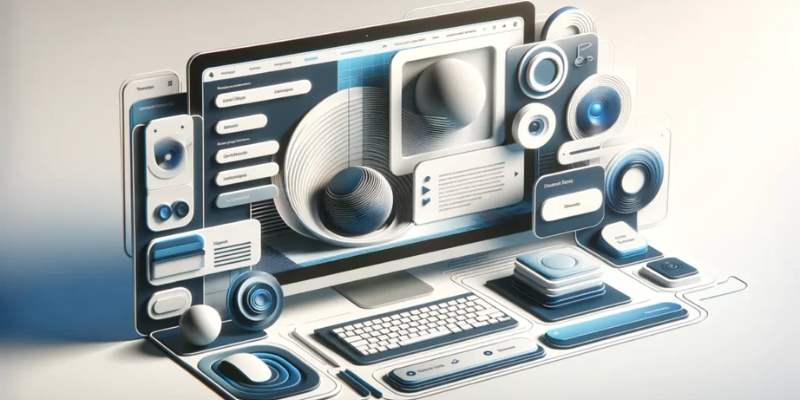The use of 3D elements in web design has revolutionized the digital experience, offering immersive and interactive visuals that captivate users. With advancements in web technologies like WebGL, Three.js, and CSS3, integrating 3D graphics into websites is now more accessible than ever. These elements not only enhance aesthetics but also improve user engagement and brand perception. This blog explores the various ways to incorporate 3D elements into a website and best practices to ensure a seamless experience. If you’re looking to enhance your skills, a Web Designing Course in Chennai can help you master these cutting-edge techniques.
Benefits of Using 3D Elements in Web Design
1. Enhances User Engagement
3D elements create visually compelling experiences that encourage users to interact with the website. Interactive models, animations, and effects make the content more appealing, increasing session duration and reducing bounce rates.
2. Improves Brand Identity
Integrating 3D visuals helps establish a unique brand identity. Custom 3D graphics, product models, and interactive elements make a website stand out, reinforcing brand recognition and credibility.
3. Provides a Realistic Product View
For eCommerce and product-based businesses, 3D models allow users to view products from different angles, zoom in, and even interact with them. This enhances the shopping experience, leading to higher conversion rates.
4. Creates Immersive Experiences
With 3D animations and effects, storytelling becomes more engaging. Websites for industries like gaming, architecture, and entertainment benefit from immersive 3D elements that offer a richer user experience. If you’re looking to learn how to create such websites, a Web Designing Course can equip you with the necessary skills and knowledge.
How to Implement 3D Elements in a Website
1. Use WebGL for High-Quality 3D Graphics
WebGL (Web Graphics Library) is a JavaScript API that allows rendering 3D graphics within the browser. It provides high-performance visual effects and is widely used for interactive 3D elements.
Example: WebGL-powered interactive product showcases or virtual tours enhance user interaction.
2. Integrate Three.js for Easy 3D Rendering
Three.js is a popular JavaScript toolkit that simplifies WebGL implementation, allowing developers to easily construct 3D scenes, objects, and animations.
Example: A 3D spinning logo or animated background using Three.js adds dynamism to the website.
3. Utilize CSS3 and SVG for Lightweight 3D Effects
While not as powerful as WebGL, CSS3 and SVG can create subtle 3D effects such as depth, shadows, and animations without impacting performance.
Example: CSS3 transforms and shadows can give a button or image a 3D-like appearance.
4. Leverage 3D Models for Product Showcases
Businesses selling physical products can integrate 3D models to allow users to explore items in detail. Formats like .glTF and .OBJ are commonly used for web-friendly 3D models.
Example: An online furniture store offering 360-degree views of products enhances the customer’s buying decision.
5. Add Parallax Scrolling for Depth Perception
Parallax scrolling creates an illusion of depth by making background elements move at different speeds than foreground elements. This effect is often used in storytelling and landing pages.
Example: A website with a 3D layered scrolling effect enhances visual appeal and interactivity.
6. Optimize Performance for Faster Loading
While 3D elements enhance aesthetics, they can slow down a website if not optimized. Strategies like lazy loading, compressed textures, and efficient coding practices ensure smooth performance. To learn more about optimizing websites for performance, consider enrolling in a Web Development Course in Chennai.
Example: Using low-poly models or compressed assets prevents excessive load times.
Best Practices for Using 3D in Web Design
1. Keep It User-Friendly
Ensure that 3D elements do not overwhelm the user. They should enhance the user experience rather than distract or slow down navigation.
2. Maintain Mobile Compatibility
Many users access websites on mobile devices, so 3D elements must be responsive and lightweight to function smoothly across different screen sizes.
3. Balance Aesthetics with Functionality
While 3D elements can make a website visually stunning, they should serve a purpose. Avoid unnecessary animations or effects that might hinder usability.
4. Test Performance Across Browsers
Different browsers may handle 3D graphics differently. Testing on Chrome, Firefox, Safari, and Edge ensures consistency across all platforms.
3D elements in web design provide an innovative way to enhance user engagement, improve brand perception, and create interactive experiences. Whether using WebGL for high-end graphics, Three.js for interactive animations, or CSS3 for subtle effects, the right approach depends on the website’s goals and audience. By optimizing performance and ensuring user-friendliness, 3D elements can transform a standard website into an extraordinary digital experience. Consider joining a Training Institute in Chennai to gain expertise in incorporating such elements.
